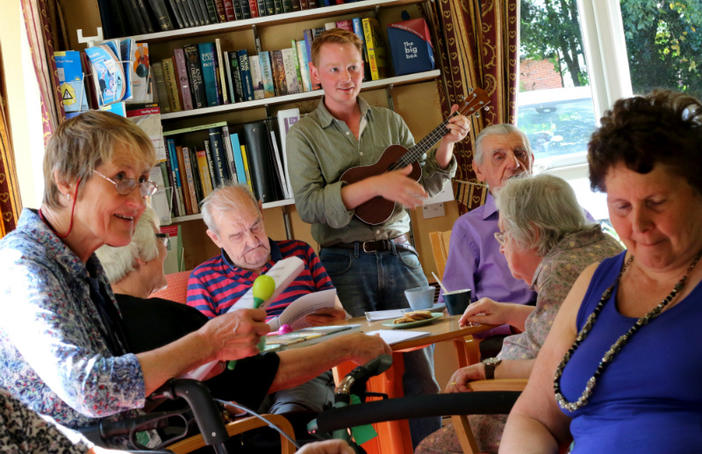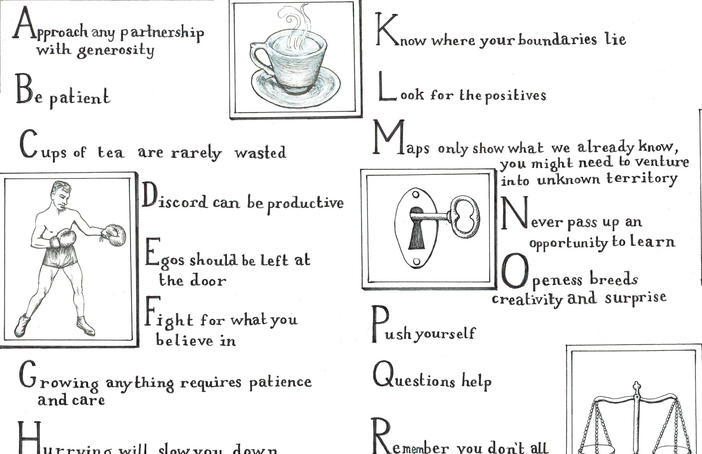Blog Post
What makes a successful partnership?
Lisa Blaney and Steve Hodgkins talk about what makes a strong partnership

Lisa Blaney, Arts for Health Manager at bait, and Steve Hodgkins, a serving police officer and the founder of Jobs, Friends & Houses who work with Left Coast, talk to Eleanor Turney about what makes a strong partnership.
“Last night,” says Lisa Blaney, “I was writing down all the partners we work with, and I was thinking ‘wow this is pretty diverse!" For bait, with its focus on well-being, the arts-in-health agenda is high on its list, and is where some of its more fruitful partnerships have been: “We’re working with family centres in South East Northumberland,” continues Lisa Blaney, “so that’s Barnado’s and Action for Children. We work in partnership with Sage Gateshead and the Alzheimer’s Society to deliver music sessions. We also work with Northumberland Recovery Partnership (NRP) who support people presenting with substance misuse issues, and Escape Family Support, which is a charity supporting people who care for somebody with substance misuse problems.
“We work very closely to support people to incorporate art into their everyday life, to give them a healthier focus. Art in particular fits very well in the substance misuse world because it’s very much about mindfulness and relaxation, and bringing out individual creative skills and strengths, which gives people a purpose and a feeling of wellness and achievement."
For Steve Hodgkins, a member of LeftCoast’s steering group, “when somebody’s been really marginalised in society, when they’ve been on the edge and they haven’t had anything, when they’ve only ever looked forward to their next drink or their next drug hit, we want to replace that with great positive things – and that’s really where art and culture gives an amazing opportunity to fill that need. The ability of art and culture to stimulate the mind and actually provide enjoyment and happiness and thought-provoking feelings and emotions, I think it’s an incredible way to do that.”
LeftCoast also has a focus on community cohesion and wellbeing, and, as they describe, “many of our projects now use community members to help generate ideas and influence specific programmes”. Hodgkins says: “My role [as a police officer] has always been about community engagement, community participation, with a view that if you can support individuals, you can support families and you can support communities, which will in turn reduce crime and antisocial behaviour.”
He was not, however, an obvious arts advocate – “I’ve never, ever been involved in the arts, I’ve never really understood it or got into it” – but once he made the decision to explore Creative People and Places, he quickly became a convert: “I had this email come in that talked about Blackpool bidding for CPP funding, and wanting independent steering group members. As soon as it said ‘arts’ I just deleted it. But then I was at a point at my life where I was thinking, right, Steve, get out of your comfort zone, so I came back down and I got it out of my delete box.”
“I read it through again, and I thought, this actually makes sense, I can see how this will support individuals, families and communities. My expertise, knowledge and skill set were in community engagement, particularly in relation to vulnerable members of the community, so I applied to be a steering group member. I was successful, so that then started me on this amazing journey of uncovering and exploring and understanding the real power, benefit and potential that arts and culture can bring to individuals, families and communities.”
Hodgkins sees Blackpool as a good example of where CPP has made a real difference. Being part of the steering group, along with a diverse range of people and partners, allows him to see “the whole theory behind Creative People and Places coming to fruition, and I love that. I come across a lot of theories in my life that are great words on a bit of paper but they don’t actually translate into anything meaningful. But I’ve actually seen, witnessed and it’s evidenced the massive impact that Left Coast has had.”
This work has been successful because of LeftCoast’s many partners, and I ask Hodgkins why LeftCoast’s community partners have been so important: “True partnerships are where both parties benefit – either directly or indirectly, and sometimes the reciprocation may take a while before it is given. However I come across too many organisations that feel partnership working is you scratch my back and… nothing is given in return! It’s challenging, isn’t it, because unfortunately so many things come down to money and cost-benefit. It can be quite cold – all those facts and figures – but actually this is about people.”
As with all CPP projects, money and becoming sustainable are also very important to bait’s work, and two of their partner projects have now secured their own funding: “We’ve been able to work with some partners for them to secure their own money, so we now don’t give them any financial support at all. So the Escape partner, they’ve got money from the Arts Council’s Grants for the Arts scheme, and they’re doing a photography project with all of their carers and service users. And Northumberland Recovery Partnership have got Rayne Foundation money, and they do visual art and exhibition work. So they were able to bring in £33,000 between them.”
Lisa Blaney is very clear on the importance of recognising the specific skills and expertise that each partner brings to the table, and capitalising on those skills: “One of the things about the partnership work is we’re using everyone’s expertise in a different way and that works really well. For example, I don’t really understand dementia or what living with someone who has it would be like. However, we’ve got the arts expertise, we would know what artistic form would be perfect to support that memory recognition.”
Blaney is also clear on what she and the bait team can offer to the local area, and what they need to source from their partners: “The most important thing is trust and building up the relationship. bait has gone in and developed a very open, transparent relationship with the partnerships and organisations that have helped to sustain work. Honesty and transparency, that’s our mission. We’re going to collaborate but be really honest about what we can’t do as well as what we can do.”
“One of the things we’re doing is really looking at utilising each other’s skills. All egos are put out the door, and we think about who we’re here for, and who is the most skilled, where is the strength coming from? Is it from the art or the emotional or social part of it? You’ve got to be transparent and very honest about your aims. You cannot be shoehorning anything in that doesn’t fit in the long run.”
Hodgkins agrees on the importance of listening when building a partnership: “My best partnerships are built by meeting in person, looking them in the eye while talking, and listening to what they have to say. It is about under-promising and over-delivering. It is about being honest and sincere even when it’s tough news to give.”
What advice would Blaney give to other projects looking to forge strong partnerships? “You’ve got to be very respectful of the organisations you’re working with, of their methodologies and their ethos. Do you fit or are you just worlds apart? But also you need to collaborate and that means giving power away sometimes. I’ve gone from sitting with the money and the power, to being invited onto other panels to help make decisions. It’s just the most wonderful thing to give power away when they’re ready, to position yourself where you’re the learner and they’re the expert. But it takes time and trust, honesty and collaboration to get to that position. They’ve got their own money, their own skills, their own expertise. And they’re off.”
Extract from An A-Z of Partnerships below is by Nicole Mollett and Sarah Butler as part of the More Than 100 Stories commission. See the full image and more of their creative work on the theme of partnership.








